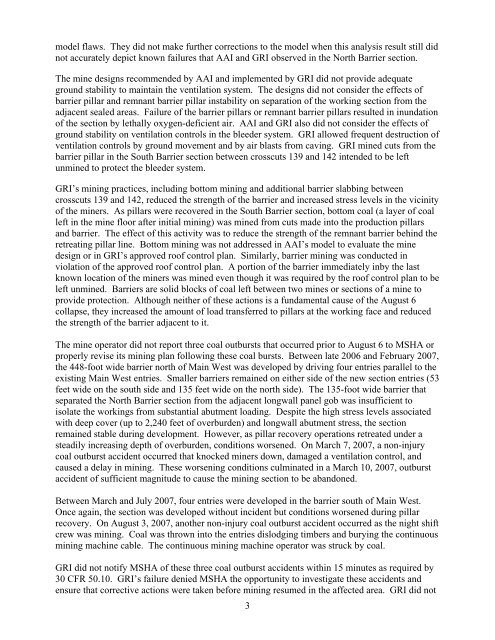Mine Safety and Health Administration (MSHA) - Report of ...
Mine Safety and Health Administration (MSHA) - Report of ...
Mine Safety and Health Administration (MSHA) - Report of ...
You also want an ePaper? Increase the reach of your titles
YUMPU automatically turns print PDFs into web optimized ePapers that Google loves.
model flaws. They did not make further corrections to the model when this analysis result still did<br />
not accurately depict known failures that AAI <strong>and</strong> GRI observed in the North Barrier section.<br />
The mine designs recommended by AAI <strong>and</strong> implemented by GRI did not provide adequate<br />
ground stability to maintain the ventilation system. The designs did not consider the effects <strong>of</strong><br />
barrier pillar <strong>and</strong> remnant barrier pillar instability on separation <strong>of</strong> the working section from the<br />
adjacent sealed areas. Failure <strong>of</strong> the barrier pillars or remnant barrier pillars resulted in inundation<br />
<strong>of</strong> the section by lethally oxygen-deficient air. AAI <strong>and</strong> GRI also did not consider the effects <strong>of</strong><br />
ground stability on ventilation controls in the bleeder system. GRI allowed frequent destruction <strong>of</strong><br />
ventilation controls by ground movement <strong>and</strong> by air blasts from caving. GRI mined cuts from the<br />
barrier pillar in the South Barrier section between crosscuts 139 <strong>and</strong> 142 intended to be left<br />
unmined to protect the bleeder system.<br />
GRI’s mining practices, including bottom mining <strong>and</strong> additional barrier slabbing between<br />
crosscuts 139 <strong>and</strong> 142, reduced the strength <strong>of</strong> the barrier <strong>and</strong> increased stress levels in the vicinity<br />
<strong>of</strong> the miners. As pillars were recovered in the South Barrier section, bottom coal (a layer <strong>of</strong> coal<br />
left in the mine floor after initial mining) was mined from cuts made into the production pillars<br />
<strong>and</strong> barrier. The effect <strong>of</strong> this activity was to reduce the strength <strong>of</strong> the remnant barrier behind the<br />
retreating pillar line. Bottom mining was not addressed in AAI’s model to evaluate the mine<br />
design or in GRI’s approved ro<strong>of</strong> control plan. Similarly, barrier mining was conducted in<br />
violation <strong>of</strong> the approved ro<strong>of</strong> control plan. A portion <strong>of</strong> the barrier immediately inby the last<br />
known location <strong>of</strong> the miners was mined even though it was required by the ro<strong>of</strong> control plan to be<br />
left unmined. Barriers are solid blocks <strong>of</strong> coal left between two mines or sections <strong>of</strong> a mine to<br />
provide protection. Although neither <strong>of</strong> these actions is a fundamental cause <strong>of</strong> the August 6<br />
collapse, they increased the amount <strong>of</strong> load transferred to pillars at the working face <strong>and</strong> reduced<br />
the strength <strong>of</strong> the barrier adjacent to it.<br />
The mine operator did not report three coal outbursts that occurred prior to August 6 to <strong>MSHA</strong> or<br />
properly revise its mining plan following these coal bursts. Between late 2006 <strong>and</strong> February 2007,<br />
the 448-foot wide barrier north <strong>of</strong> Main West was developed by driving four entries parallel to the<br />
existing Main West entries. Smaller barriers remained on either side <strong>of</strong> the new section entries (53<br />
feet wide on the south side <strong>and</strong> 135 feet wide on the north side). The 135-foot wide barrier that<br />
separated the North Barrier section from the adjacent longwall panel gob was insufficient to<br />
isolate the workings from substantial abutment loading. Despite the high stress levels associated<br />
with deep cover (up to 2,240 feet <strong>of</strong> overburden) <strong>and</strong> longwall abutment stress, the section<br />
remained stable during development. However, as pillar recovery operations retreated under a<br />
steadily increasing depth <strong>of</strong> overburden, conditions worsened. On March 7, 2007, a non-injury<br />
coal outburst accident occurred that knocked miners down, damaged a ventilation control, <strong>and</strong><br />
caused a delay in mining. These worsening conditions culminated in a March 10, 2007, outburst<br />
accident <strong>of</strong> sufficient magnitude to cause the mining section to be ab<strong>and</strong>oned.<br />
Between March <strong>and</strong> July 2007, four entries were developed in the barrier south <strong>of</strong> Main West.<br />
Once again, the section was developed without incident but conditions worsened during pillar<br />
recovery. On August 3, 2007, another non-injury coal outburst accident occurred as the night shift<br />
crew was mining. Coal was thrown into the entries dislodging timbers <strong>and</strong> burying the continuous<br />
mining machine cable. The continuous mining machine operator was struck by coal.<br />
GRI did not notify <strong>MSHA</strong> <strong>of</strong> these three coal outburst accidents within 15 minutes as required by<br />
30 CFR 50.10. GRI’s failure denied <strong>MSHA</strong> the opportunity to investigate these accidents <strong>and</strong><br />
ensure that corrective actions were taken before mining resumed in the affected area. GRI did not<br />
3
















